
Did You Hear? Oracle Retained the Cup!
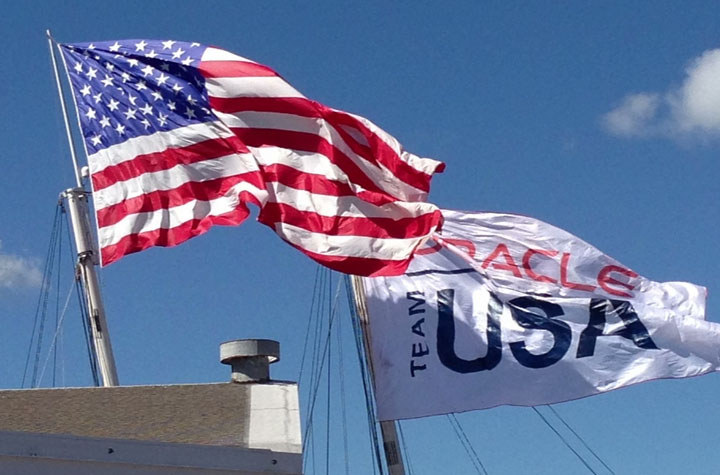
© Latitude 38 Media, LLC
Of course you did.
Now for the aftermath. A lot of Kiwis are asking how Oracle could have come from the verge of elimination to win eight straight races to retain the Cup. Wasn’t there something fishy?
Larry Ellison told the press that the turnabout was because: 1) Spithill was sailing lower and faster rather than higher and slower — as repeatedly suggested by Russell Coutts; 2) better tactics and crew work; and 3) Oracle engineers had "broken the code." Ellison wouldn’t give any details on "the code," suggesting he’d be in big trouble with Coutts — "our leader" — if he did.
Actually, Ellison gave the third reason first, and added the other two later almost as afterthoughts.
It’s no secret that Oracle, which had been decidedly slower upwind at the start of the Cup, was decidedly faster upwind — particularly foiling upwind — in the second half of the Cup. In fact, both Dalton and Barker knew they were toast going into the last race unless the wind was really light or something else weird happened.
Some say that Oracle had new foils flown up from Larry’s "special boatbuilder" in New Zealand, and that did the trick. On the other hand, Spithill said Oracle used the same foils throughout the Cup. Of course, after a U.S. President told the nation "I did not have sexual relations with that woman," it was proven that you can mouth something that’s technically correct but nonetheless completely misleading. Not that we’re saying that’s what Spithill did.
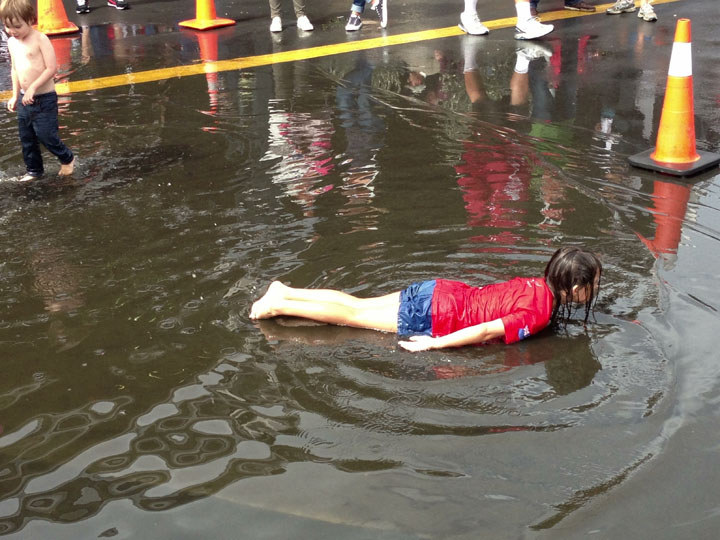
© Latitude 38 Media, LLC
For what it’s worth, the Kiwis did not use the same foils throughout the series. Sometimes they used the slower but more forgiving J-shaped foils, sometimes they used the less forgiving L-shaped foils similar to Oracle’s.
The current theory is that Oracle got much faster because they came up with an auto-stabilization system for the foils, while the Kiwis had an inferior manual model.
The Kiwis are said to have protested the use of the device prior to the start of the Cup, but the protest had been filed too late. But — and this is a really big but — the international jury said that had the protest been received in time, they most likely would have allowed the device and denied the Kiwi protest.
So you have to wonder, if Oracle had the auto device the whole time, why were they so slow in the beginning of the Cup?
Want to get into the nitty-gritty of Oracle’s auto-stability system, which kept the boat rock steady foiling upwind compared to the Kiwi’s inferior manual system and why Oracle’s system might be technically legal but borderline fair? Read the letter at the end of this report.
The thing to remember is that from the very beginning, the America’s Cup has been a design competition, not a level contest between sailors. At the last press conference, a glum Grant Dalton acknowledged and congratulated Oracle on their technological success. He didn’t say they were better sailors.
The moral of the 34th Cup would seem to be, in a tech race, the team with the nearly unlimited funds has the advantage over the team that doesn’t know where their next set of foils is coming from. Which is why we’ve always wanted the America’s Cup to be contested in one-designs, or near one-designs, so it would be more of a sailors’ race than a designers’ race.
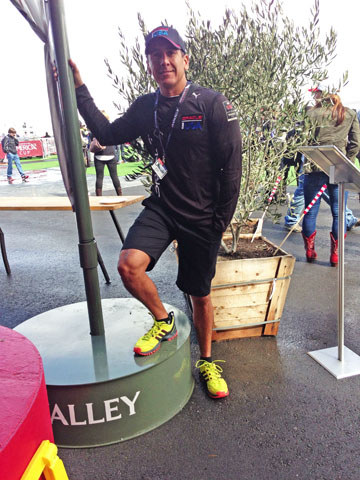
© Latitude 38 Media, LLC
This is not to take anything away from the Oracle team. Led by Coutts behind the curtains and the resolute Spithill on the boat, they never gave up, and came back from certain defeat on several occasions. It was brilliant, and we salute them. We also salute Coutts and Ellison, as they really did come up with something spectacular beyond our imagination. Let’s hope they can keep it up, on San Francisco Bay again, but with five times as many entries because of lower costs.
Now for the letter, which was written by a "Kiwi technology bloke," and spread around by Alan Wiltshire of Takapuna Beach, New Zealand. It purports to explain how Oracle got so fast and how legal it was:
THOUGHTS REGARDING ORACLE’S REMARKABLE PERFORMANCE TURNAROUND.
1. It is well recognized that Oracle was having serious foiling stability difficulties at the outset of the regatta and that their performance could not match that of ETNZ.
2. Halfway through the series, it was acknowledged that Oracle had fitted an automatic control to their hydrofoil trim, and that this modification was approved by the measurement authorities.
3. Since this modification, Oracle’s performance has almost unbelievably improved. This has been ‘explained’ by skipper Jimmy Spithill as being due to the superhuman efforts of the crew to improve their handling skills. However, in view of the intensive training Oracle were able to do, prior to the regatta, with their highly skilled team partner, it seems unlikely that only now have they discovered the “magic bullet” they clearly have. It is much more likely to be the result of the modifications, possibly enabled by their surprising decision to use their lay day card and the subsequent lucky postponements.
4. It must be remembered that this is the first time that this contest has been sailed by yachts ‘flying’ on hydrofoils, and it is probable that new and different criteria should have been applied.
5. In the aeronautical world it has long been known that the stability of swept wing aircraft can rapidly be lost by uncontrolled yaw leading to a dangerous situation known as ‘Dutch Roll’.
6. A device known as ‘Little Herbie’ was developed during the commissioning of the Boeing 747 Jumbo Jets over 40 years ago, to overcome this tendency. Little Herbies, or Stability Augmentation Systems (SAS) as these are now designated, are equipped with sensors such as accelerometers and gyros which can detect and instigate corrections to stability with a speed and accuracy which exceeds the ability of even experienced airline pilots. They are therefore now installed in virtually all swept-wing aircraft.
7. The ‘legality’ of this device has been justified and accepted on the basis that it does not actually ‘drive’ the trim of the foils — this is still performed by the muscle power of the crew, via hydraulic linkages. That may be so, but the device, using it’s sensing and directives, has been described as ‘automatic’. This implies that the trim of the foils is determined by what can only be described as ‘superhuman’ technology. If this technology has been used to overcome the foiling stability difficulties of Oracle, it will have enabled the use of higher speed/lower drag foils which the crew would otherwise be unable to manage. This would give a significant speed advantage during foiling. This has been clearly in evidence since the modification. Improvement in stability and speed has been staggering.
8. The high speed/low drag foils do have a downside in light conditions where, due to their lesser lifting characteristic, foiling is difficult or impossible. This was also clearly seen in the abandoned Race #13 when ETNZ were only four minutes from the finish, with a lead of over 1000 meters.
9. ETNZ appears to have worked within the constraints of accepted yacht racing rules and the special America’s Cup 2013 Racing Rules to achieve foiling with these craft. This has been at the cost of using foil characteristics and controls which can be successfully managed by a skilled crew while having to make some concession to pure speed.
10. Although there is risk of being derided for being a poor loser or a bad sport it can not go un-noticed that Team Oracle have already been penalized for cheating, and that previous Defenders have been noted for sailing very close to the wind of rule compliance. The recent outpouring of bluff and arrogance from Jimmy Spithill may well be part of a plan to trail red herrings and to draw the attention off the real technological reason for their quite literally astounding comeback.
11. The question is whether the use of a device which can enhance performance in excess of that achievable by human endeavour should be allowed in a sporting contest?
12. Is this grounds for protest? At least we should all be aware that this is how desperate sporting entertainment has become.
Australia to be AC35 Challenger
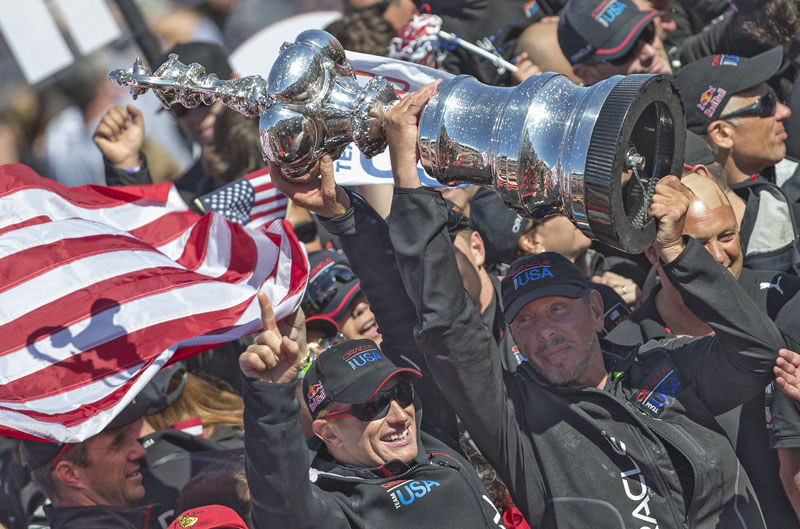
Having won the Cup two times in four attempts, a champagne-splashed Ellison told the press that he had already received a challenge for the next America’s Cup. He declined to say who it was from, but the next day’s rumors had it coming from Australia. According to trusted waterfront sources, the plan to insure this outcome was put in place even before conclusion of the last race, as Golden Gate Commodore Norbert Bajurin was reportedly sequestered aboard one of Larry Ellison’s boats Wednesday so that no one could serve him with an official challenge before the Australians, who did so shortly after Oracle Team USA’s win was confirmed in AC 34’s 19th race.
Our sources did not tell us the name of the Aussie challenger, but American and Australian news sources claim the challenge came from Hamilton Islands YC of Queensland, Australia. The island is reportedly owned by wine industry multi-millionnaire Bob Oatley, 82. This would be the first Aussie challenge since 2000, although Australia, of course, was the first nation other than the U.S. to capture the Auld Mug. Thirty years ago the Aussies, funded by business mogul Alan Bond, defeated Dennis Conner’s Liberty with Australia II (distinctive due to its revolutionary wing keel), skippered by John Bertrand. That effort was Bond’s fourth AC attempt.
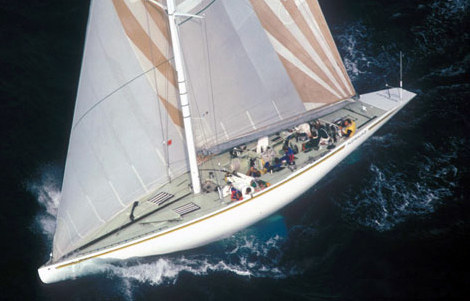
©2013 Latitude 38 Media, LLC
Oracle Team USA’s frequent spokesman Tom Ehman, who is vice commodore of the GGYC, would neither confirm nor deny that an Australian campaign will be the next challenger, but he did confirm that a challenge has be received. The challenge also raises the question of whether key Oracle Team USA crewmen Jimmy Spithill, Tom Slingsby, Kyle Langford and Joey Newton will stay with the team, as all are Australians. Will a fat Oracle paycheck trump national loyalty as it has for New Zealand-born OTUSA CEO Russell Coutts?
Meanwhile, Ellison acknowledged that one of the biggest challenges of the next America’s Cup will be to "get more countries to participate while keeping the event as spectacular as it was this year." At first glance, it would seem that the easiest path to that goal would be to go with one-designs, or at least have most of the more critical and expensive parts be one-design, and eliminate the wings in favor of soft sails. We’re not against wings in principle, and the technology is already there. The problem is that they require so many people — 30 to 50 in the case of the 72s — to step and unstep each day. Suddenly the team payroll becomes astronomical. While MOD70s trimaran — or something similar — might not be quite as fast or quite as thrilling as the AC72s, they can certainly be a lot less expensive to build and maintain.
In the right wind conditions, 10 knots to about 22 knots instead of 5 knots to 33 knots as originally planned, the AC72s proved to be spectacular boats. The fact that they are unsustainably expensive to maintain and difficult to sail means it’s unlikely that were going to see anything quite as spectacular anytime soon — although a source inside the Oracle camp told us they will be shipped, along with five years of spare parts, to Ellison’s island of Lanai. What he would do with them there is beyond us. But we are going to miss seeing them streaking across San Francisco Bay.
Ellison’s other challenge is with the city of San Francisco. While Mayor Ed Lee has stated he wants the America’s Cup to come back, a lot of San Francisco officials and residents have such hatred for the ultra-rich that they’d cut off their noses to spite their faces. Like Ellison or not — he said he doesn’t take it personally if local sailors supported the Kiwis, as many did — the America’s Cup brought a lot of people, good publicity and tons of money to San Francisco. If the next Cup has 10 syndicates or more, we believe it would attract a lot more people and superyachts, the latter being another attraction that people love or love to hate — it would be a great thing.
The current status is that Ellison will discuss the site of the next America’s Cup with senior members of the team, and with local government officials. He says he personally would like to see it stay on the Bay, if possible. He cited the beauty, the great sailing conditions — and the fact that he has a home here. But honestly, having seen these spectacular sailing machines match racing and reaching speeds of up to 47.57 knots where everyone can see them from shore, how could the America’s Cup be held anywhere else?
But now is not the time to worry about such things. Let’s just savor the incredible sailing spectacle that we were lucky enough to be able to experience — with a giant assist from Stan Honey and his LiveLine team — and the incredible comeback on the part of Oracle Team USA. It truly was one for the ages.
Rolex Big Boat Series Takes Over
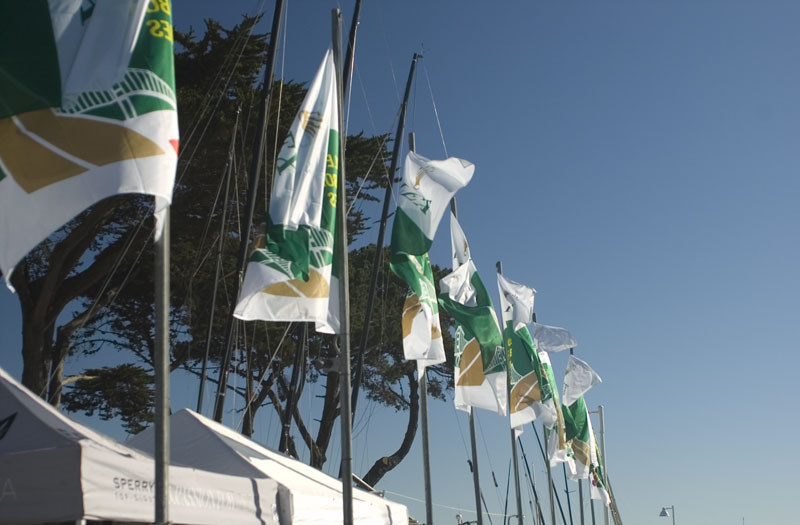
The America’s Cup ended just in time for St. Francis YC’s signature regatta, the Rolex Big Boat Series, to take over San Francisco Bay yesterday. Usually held on the second Thursday-Sunday of September, RBBS was scheduled for the end of the month in order to accommodate AC 34. What effect will the later time slot have? So far, it’s resulted in lighter wind and warmer air temperatures, as San Francisco transitions from summer to fall conditions.
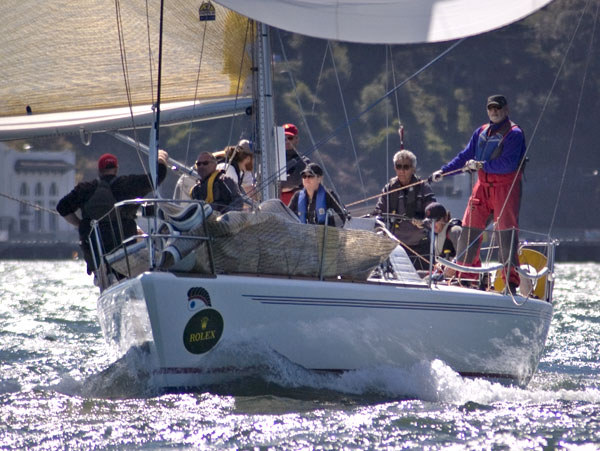
Yesterday’s breeze went from light to moderate, up to 20 knots, and the regatta was able to get in three races for the new J/70 class and two for everyone else. So far so good. The TP52s Vesper and Beecom are the two biggest monohulls; Vesper won both races on Thursday. In IRC-B, Sy Kleinman’s Schumacher 54 Swiftsure, a regular on this race course, also scored two bullets. Dan Thielman’s R/P 44 Tai Kuai in HPR recorded two wins as well. In the 38-boat Melges 24 Pre-Worlds, which is having some issues with protests and appeals, Franco Rossini’s Swiss entry Blu Moon tops the leaderboard. Frank Slootman’s new J/70 Little Hand won Boat of the Day, a new award.
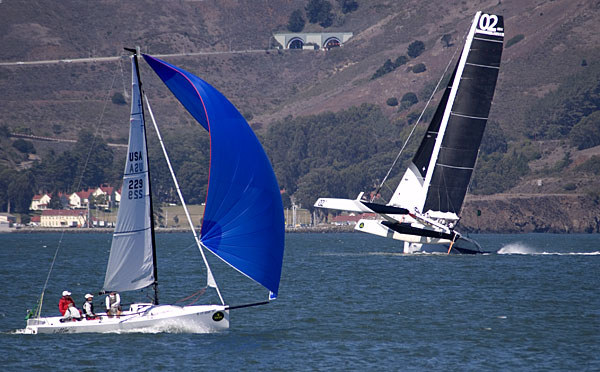
Friday morning is starting with a shoreside postponement of at least an hour, while we wait for the desired westerly to overpower the morning easterly. Follow along at www.rolexbigboatseries.com, or, better yet, especially if you’re already in the habit, come down to Crissy Field to watch in person.
